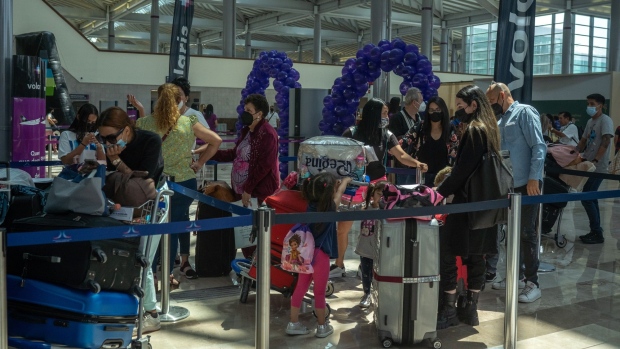Aug 16, 2022
AMLO's Little-Used Airport in Mexico Can Become International Hub, Viva Aerobus Says
, Bloomberg News

(Bloomberg) -- Mexico’s newest airport has the capacity and infrastructure to become the capital’s main international hub, according to the head of one of the country’s largest carriers.
Despite offering just a handful of flights each day, Felipe Angeles International Airport is “undoubtedly” capable of supplanting Mexico City’s main airport known as Benito Juarez in the coming years, Grupo Viva Aerobus SAB Chief Executive Officer Juan Carlos Zuazua said in an interview.
“They built a good airport. It has infinitely larger capacity -- the terminal is one kilometer long,” he said. “It’s just a matter of how users are going to become familiarized with this airport. It’s not going to happen overnight, it takes time.”
Since opening in March to relieve traffic at the main hub, Felipe Angeles hasn’t won many supporters. Critics say the airport’s location -- about 50 kilometers (31 miles) north of the city’s center -- is far from ideal and that the converted military base is not a good place for a commercial airport, given the area’s unique geography. Others point to the unfinished roads surrounding the airport, saying the project was rushed along on a shoestring budget.
Read More: AMLO’s New Airport Opens With Hoopla, Criticism, 8 Flights a Day
The airport was the first of President Andres Manuel Lopez Obrador’s large infrastructure projects to be completed, and if it’s going to overtake Benito Juarez, Felipe Angeles has a long way to go.
The new airport handled fewer than 1,200 flights from its March inauguration until June, the latest available data show. By comparison, Benito Juarez handles more than 900 operations per day, on average.
No IPO, For Now
While Viva Aerobus’s stature has grown as it has overtaken legacy carrier Grupo Aeromexico SAB in domestic passengers, the carrier isn’t planning on an initial public offering in the short term, Zuazua said.
“It depends on the markets, but also on the fact that the company isn’t in need of cash flow,” he said. “Our fleet is fully financed. It’s about finding the right timing and weighing if it makes sense for the company.”
In December, Allegiant Travel Co. said it would make a $50 million equity investment in Viva Aerobus as part of a commercial agreement to expand low-cost, nonstop flight alternatives between the US and Mexico.
But the alliance won’t be able to produce any new flights between the two countries until Mexico regains its aviation-safety ranking by the US Federal Aviation Administration. A downgrade to Category 2 in May of 2021 prohibited an expansion of flights from Mexican carriers to its northern neighbor.
“The government has been doing a good job in trying to get the category back, which will hopefully happen toward the end of the year, or early next year,” he said. “But we don’t really have visibility into the process, it’s all handled between authorities.”
Domestic Growth
Just four years ago, Viva Aerobus was fourth in Mexico’s domestic market by passengers, carrying 9.1 million domestic travelers in 2018. It trailed Volaris, Aeromexico and Interjet.
But the pandemic led Aeromexico to file for Chapter 11, which it successfully exited earlier this year. The upheaval also proved too much for Interjet, which already had significant financial problems before Covid slammed the travel industry.
Viva Aerobus swept in to grab some of that low-cost market share, carrying more than 15 million passengers in 2021, a number Zuazua sees climbing to 20 million this year.
“We’re not interested in market share, we’re interested in growing the market, in attracting new travelers who currently take buses for 450-kilometer trips,” he said.
©2022 Bloomberg L.P.







